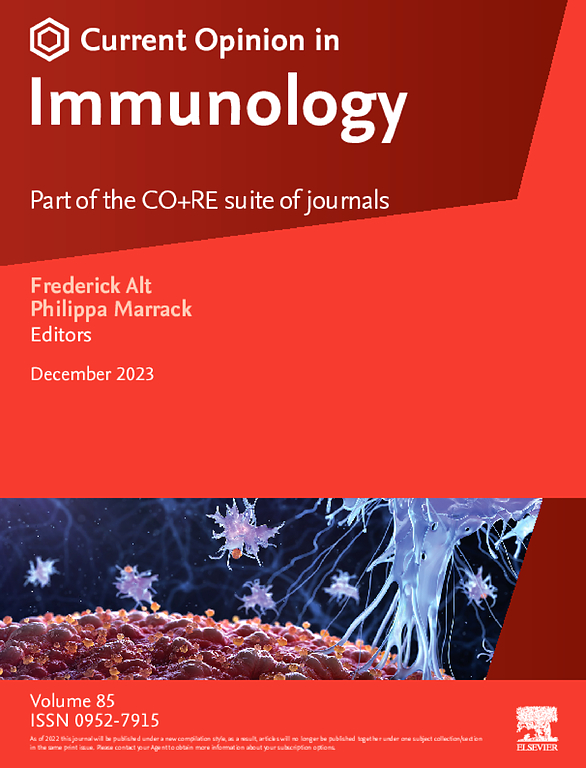Microglia and myeloperoxidase in neuroinflammatory and neurodegenerative diseases
IF 5.8
2区 医学
Q1 IMMUNOLOGY
引用次数: 0
Abstract
The dogma of an impenetrable blood–brain barrier (BBB) has given way to the view that resident immune cells within the central nervous system respond to a variety of blood-borne soluble factors, particularly cytokines, and play an important functional role. In particular, microglia cells contribute to the regulation of neuroinflammation, with both protective and pathological roles. Specific microglia activation states variably influence the progression of neuroinflammatory and neurodegenerative diseases, including Alzheimer's disease, Parkinson's disease, multiple sclerosis, and amyotrophic lateral sclerosis. Significant evidence indicates that gut microbiota–derived products regulate microglial function across the lifespan and influence the BBB. Myeloperoxidase (MPO) catalyzes the conversion of hydrogen peroxide and chloride ions into hypochlorous acid, a potent oxidant implicated in oxidative tissue damage and modulation of inflammatory signaling. Elevated MPO levels in the central nervous system have been correlated with human disease and the dysregulation of MPO activity in microglia is particularly detrimental, as it amplifies the oxidative stress, disrupts the BBB integrity, and potentiates the neuroinflammatory cascades through the activation of transcription factors like NF-κB. Targeting MPO activity through selective inhibitors or antioxidant strategies may attenuate microglial activation and reduce neuroinflammation, highlighting its potential as a therapeutic target, but the regulatory mechanisms governing MPO expression in microglia and its interplay with other inflammatory mediators remain poorly understood. New research efforts into the relationship between gut microbiota, microglia, MPO, and neuroinflammation are essential to unravel the complexities of neuropathology in a variety of conditions beyond neurodegenerative diseases.
神经炎症和神经退行性疾病中的小胶质细胞和髓过氧化物酶。
不可逾越的血脑屏障(BBB)的教条已经让位于中枢神经系统内驻留的免疫细胞对各种血源性可溶性因子,特别是细胞因子作出反应,并发挥重要的功能作用的观点。特别是,小胶质细胞有助于调节神经炎症,具有保护和病理作用。特定的小胶质细胞激活状态不同地影响神经炎症和神经退行性疾病的进展,包括阿尔茨海默病、帕金森病、多发性硬化症和肌萎缩侧索硬化症。重要的证据表明,肠道微生物衍生的产物在整个生命周期中调节小胶质细胞的功能并影响血脑屏障。髓过氧化物酶(MPO)催化过氧化氢和氯离子转化为次氯酸,次氯酸是一种强效氧化剂,与氧化组织损伤和炎症信号调节有关。中枢神经系统中MPO水平升高与人类疾病相关,小胶质细胞中MPO活性的失调尤其有害,因为它放大了氧化应激,破坏了血脑屏障的完整性,并通过激活NF-κB等转录因子增强了神经炎症级联反应。通过选择性抑制剂或抗氧化策略靶向MPO活性可能会减弱小胶质细胞的激活并减少神经炎症,突出其作为治疗靶点的潜力,但MPO在小胶质细胞中表达的调控机制及其与其他炎症介质的相互作用仍然知之甚少。对肠道微生物群、小胶质细胞、MPO和神经炎症之间关系的新研究对于揭示神经退行性疾病以外各种情况下神经病理学的复杂性至关重要。
本文章由计算机程序翻译,如有差异,请以英文原文为准。
求助全文
约1分钟内获得全文
求助全文
来源期刊
CiteScore
13.30
自引率
1.40%
发文量
94
审稿时长
67 days
期刊介绍:
Current Opinion in Immunology aims to stimulate scientifically grounded, interdisciplinary, multi-scale debate and exchange of ideas. It contains polished, concise and timely reviews and opinions, with particular emphasis on those articles published in the past two years. In addition to describing recent trends, the authors are encouraged to give their subjective opinion of the topics discussed.
In Current Opinion in Immunology we help the reader by providing in a systematic manner: 1. The views of experts on current advances in their field in a clear and readable form. 2. Evaluations of the most interesting papers, annotated by experts, from the great wealth of original publications.
Current Opinion in Immunology will serve as an invaluable source of information for researchers, lecturers, teachers, professionals, policy makers and students.
Current Opinion in Immunology builds on Elsevier''s reputation for excellence in scientific publishing and long-standing commitment to communicating reproducible biomedical research targeted at improving human health. It is a companion to the new Gold Open Access journal Current Research in Immunology and is part of the Current Opinion and Research(CO+RE) suite of journals. All CO+RE journals leverage the Current Opinion legacy-of editorial excellence, high-impact, and global reach-to ensure they are a widely read resource that is integral to scientists'' workflow.

 求助内容:
求助内容: 应助结果提醒方式:
应助结果提醒方式:


